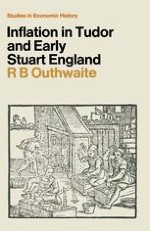1969 | OriginalPaper | Chapter
Monetary Explanations
Author : R. B. Outhwaite
Published in: Inflation in Tudor and Early Stuart England
Publisher: Palgrave Macmillan UK
Included in: Professional Book Archive
Activate our intelligent search to find suitable subject content or patents.
Select sections of text to find matching patents with Artificial Intelligence. powered by
Select sections of text to find additional relevant content using AI-assisted search. powered by
THE most important influence for many years on modern English writing about the Tudor and early Stuart inflation was the great Victorian scholar, J. E. Thorold Rogers, who spent his life collecting and processing price materials stretching from the thirteenth to the nineteenth centuries.1 On the whole Rogers had little new to say about the causes of the price rise — it was due first of all to debasement and then subsequently to Spanish-American bullion — but the weight of those seven volumes was sufficient to propel this already current orthodoxy well into the twentieth century.2 All the most important writings on English economic history duly leaned this way, though there was a gradually growing volume of minor criticisms and amendments. Cunningham and Lipson to cite two of the most influential did little more than fill out this dual-cause monetary explanation. From the late 1920s a new figure entered the ranks, the American historian, Earl J Hamilton, who began to produce his work on Spanish price history, work which related intimately the rise in Spanish prices to the influx into Spain of New World treasure.3 His importance lay not in suggesting such a connection, but in his methods, which owed much to earlier writers such as Wiebe and to the American economist, Irving Fisher.
